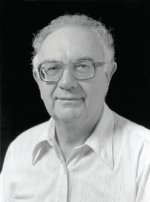George W. Beadle
George E. Burch
Dan H. Campbell
William B. Castle
Robert B. Corey
Charles D. Coryell
Lee A. DuBridge
Vernon M. Ingram
Harvey A. Itano
Karl Landsteiner
Alfred E. Mirsky
Robert M. Nalbandian
James V. Neel
A. A. Noyes
Ava Helen Pauling
Linus Pauling
Walter A. Schroeder
S. Jonathan Singer
Stanley M. Swingle
Arne Tiselius
Warren Weaver
Ibert C. Wells
Paul L. Wolf
Emile ZuckerkandlView all Key Participants
|

Portrait of S. J. Singer, approx. 2003.
More Info
S. Jonathan Singer1924-
Division of Biological Sciences, University of California, San Diego
9500 Gilman Drive, La Jolla, California 92093 - 0376
Correspondence
Pictures and Illustrations
Published Papers and Official Documents
Manuscript Notes and Typescripts
Quotes
"I have been very pleased to find Dr. Seymour Singer at work here. He seems to me
to be an excellent man, and we are looking forward to a good year's work from him."
Linus Pauling. Letter to Kurt G. Stern. August 14, 1947.
"It appears, therefore, that while some of the details of this picture of the sickling
process are as yet conjectural, the proposed mechanism is consistent with experimental
observations at hand and offers a chemical and physical basis for many of them. Furthermore,
if it is correct, it supplies a direct link between the existence of “defective” hemoglobin
molecules and the pathological consequences of sickle cell disease."
Linus Pauling. "Sickle Cell Anemia, a Molecular Disease." Science 110: 543-548. April 1949.
"The demonstration that sickle cell hemoglobin differs in electrophoretic mobility
from normal hemoglobin led to the entitled inference: 'Sickle cell anemia, a molecular
disease.' This astonishingly simple concept is of fundamental importance to medicine
for the ultimate understanding of the origins of sickness, and to biology for the
insight into what genes do. In the author's words, 'This investigation...reveals a
clear case of a change produced in a protein molecule by an allelic change in a single
gene involved in synthesis.'"
Samuel H. Boyer IV. Introduction to "Sickle Cell Anemia, a Molecular Disease." Papers on Human Genetics, 115-25. 1963.
"In 1949, application of methods of physical chemistry directly to the study of a
protein produced by a mutated gene led Pauling, Itano, Singer and Wells to identify
the specific change in the protein brought about by the gene. The discovery of the
first of the abnormal human hemoglobins which they described as causing a 'molecular
disease' -- sickle cell anemia -- was followed the identification of a large number
of other proteins, each of which owed its difference from normal structure to a mutated
gene. Ingram then showed that the change due to the mutation, in the case of each
of two abnormal hemoglobins, was confined to a single amino acid residue at one point
in one of the polypeptide chains composing the globin. There could be no doubt that
genes controlled protein structure by specifying the sequence of amino acid residues
in the polypeptide chains. The assumed basic functional correspondence was then altered
from 'one gene-one enzyme' to 'one gene-one polypeptide.'"
L. C. Dunn. "Old and New in Genetics." Bulletin of the New York Academy of Medicine, 40(5): 325-333, 329. May 1964. Audio Clips
Video Clips
|

